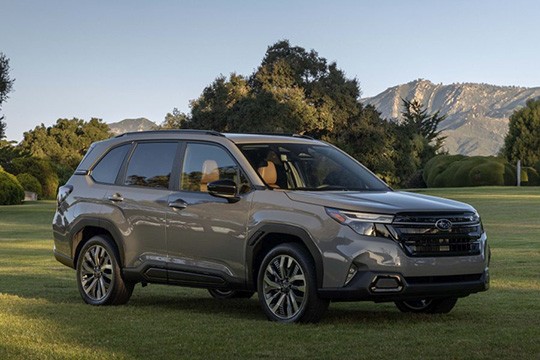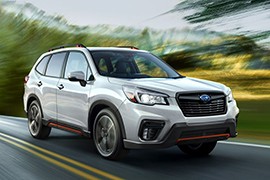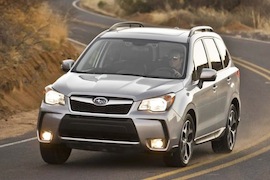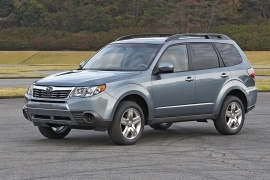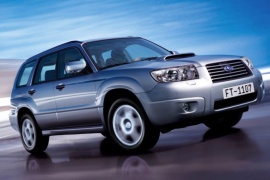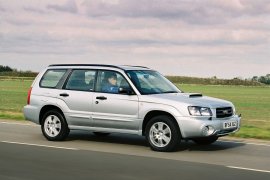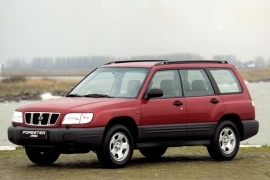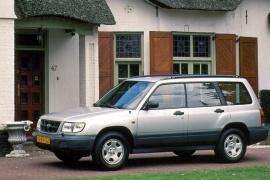SUBARU Forester Models/Series Timeline, Specifications & Photos
First production year: 1997
Engines: Gasoline, Diesel
Body style: SUV (Sports Utility Vehicle)
Subaru introduced the sixth generation of the Forester at the 2023 Los Angeles Auto Show and proved it could surprise its customers with another edition of its SUV.
Back in 1997, when Subaru introduced the first generation of the Forester, it wasn't exactly the brand's fans' favorite. Still, since it was built on the same platform as the famous Impreza, it won many hearts. Unlike its rally-winning brother, the Forester was the kind of daily driver vehicle that was good in all weather conditions and with plenty of interior room. Moreover, it was not a large vehicle despite its ability to carry five people onboard. Over time, the Forester grew in size but also gained more features. Unfortunately, it also lost some of its punchy engines.
Besides the SVX, most Subaru vehicles were not particularly attractive in terms of styling, and that didn't change too much with the sixth generation of the Forester either. Still, the automaker created a vehicle with a broad front fascia flanked by LED headlights and an appealing angular design. Moreover, the lower bumper received an apron fitted with an additional grille and flanked by a pair of side scoops for the fog lamps. The daytime running lights above the headlights looked more like eyebrows, but they matched the car's angular styling.
From its profile, the sixth generation of the Forester kept its angular shapes and had fender flares adorned by black plastic trims. Those fitted on the front even featured a set of vents resembling those installed on the Subaru WRX. Thanks to the black side sills, the car looked like it had a higher ground clearance than it actually got. The automaker installed the "Symmetrical All-Wheel-Drive" badges on the D-pillars, reminding customers that the Forester came fitted as standard with this drivetrain. Finally, the back featured a vertical tailgate flanked by corner-mounted taillights.
Inside, Subaru made the vehicle functional. In an era when most automakers offered color displays for the instrument cluster, the automaker considered that the analog dials were easier to read, so it used them. Still, there was a tiny TFT display between the tachometer and speedometer that showed various information from the onboard computer. Subaru offered a portrait-mode 11.6" infotainment screen on the center stack as an option, while the base system used a 7" one. The high-mounted front seats were separated by a center console fitted with storage areas and the gear selector. In the back, a 60/40 split-folding bench seat provided enough room for three adult-sized passengers.
Under the hood, Subaru installed its already-known naturally-aspirated 2.5-liter flat-four engine. It was paired with a CVT (Lineartronic) that sent the power in all corners via Subaru's proprietary all-wheel-drive system. The automaker offered the 2025 Forester in five grades, and all featured the same engine-gearbox combo.
The fifth generation of the Subaru Forester was launched in March 2018 at the New York International Auto Show as a 2019 model. It grew in all sizes to offer more interior room, trunk space, and comfort. But it didn't forget about safety.
Despite its not-so-appealing look (it is like a trademark for Subaru) the Forester has quite a few interesting features. Probably the most important is safety-related. The Japanese engineers managed to install a new system named DriverFocus.
This is a driver monitoring system that uses facial recognition software to identify signs of driver fatigue or driver distraction. It works with Subaru's award-winning EyeSight Driver Assist Technology to reduce the chance of an accident. For added convenience, DriverFocus can also recognize up to five drivers and remember their presets for seat position, climate, multifunction display and more.
The engine lineup is small, as usual with the Subaru vehicles. There are three options all with 4 cylinder-boxer architecture. A 2.0-liter, a 2.5-liter, and a hybrid version consist of a 2.0-liter and an electric motor. The only transmission available is a Lineartronic CVT gearbox.
The 2018 Forester claims to have better performance and lower fuel consumption than the previous generation, due to new technologies involved in the engine and transmission. It still held the symmetrical all-wheel-drive system but enhanced.
Subaru unveiled the fourth generation of the Forester crossover at the 2012 Guangzhou Motor Show, and in the following year, it released it on the U.S. market and the rest of the world.
The Forester's history started in 1997 when the Japanese automaker used the Impreza's platform to create this crossover. It was a lucky shot for Subaru, and the car made a clear difference on the market. Its superb handling and comfortable ride gave customers a pleasant experience.
With that background, the fourth generation stepped in with confidence. Its front fascia showed a bold stance with a thick chromed slat on the grille, resembling an aircraft wing. That reminded customers that once, Subaru factories used to make airplanes. The lower trapezoidal grille sported black protection and was flanked by side air intakes that channeled the air to the sides of the vehicle. From its profile, the ascending beltline emphasized the car's dynamic character. Finally, at the back, the corner-mounted taillights flanked a wide-opening tailgate.
Inside, the automaker installed bolstered seats at the front and a split-folding bench in the rear. The instrument cluster featured two large dials for the speedometer and tachometer and, squeezed between them, an LCD. Atop the center stack, Subaru placed a color display for the reversing camera, when fitted, that also acted as a screen for the onboard computer and the traction features. Yet, the infotainment unit that contained the navigation unit was placed on the center stack, making it easier to use.
Under the hood, Subaru installed a choice of two 2.0-liter gasoline units for most markets. At the same time, U.S. customers also could opt for a 2.5-liter powerplant. On the other hand, European buyers received a turbo-diesel version. All of these were flat-four engines and paired with a manual transmission as standard, while some versions were also available with Subaru's CVT gearbox named Lineartronic. As usual for the Forester, the power went in all corners.
With more and more buyers becoming interested in the crossover market, the Subaru Forester was one of the best choices available.
Looking like an SUV, with good ground clearance and even good off-road capabilities, the Forester managed to offer great fuel economy and a spacious interior.
Reaching its 3rd generation in 2008, the Forester was a relaxing vehicle to be in with the quiet ride it offered.
All-wheel-drive was standard and more engine choices were available. Don’t think of a V6 or a V8, but the 4-cylinder boxer engine didn’t feel underpowered, offering enough power to suit the needs of most buyers.
While the previous generation was more wagon-like styled, the new Forester was more crossover due to its taller stance.
Rear visibility was impressive due to the unobstructed side lines, while the large-opening panoramic sunroof enhanced the roomy interior.
Inside, the gauges were very easy to read and all controls were intuitively placed for easy reach.
Legroom and headroom were good for both the front and the rear passengers, and the chairs were comfortable to enjoy long trips.
Great cargo room was also included in the package, while even longer items could be stored with the reclining 2nd row.
Standard features included power windows, doors and mirrors, as well as a 5-speed manual transmission and hill start assist.
Depending on the trim level, the Forester was also available with a 4-speed automatic, 17-inch wheels, premium sound and a tilt-telescoping steering wheel.
Standard safety features included 6 airbags, electronic brake distribution and antilock brakes with brake assist.
Even though it was only three-years-old, the second generation of the Subaru Forester was refreshed in 2005, improving the sporty Japanese medium SUV.
The introduction of the Euro 4 pollution norms in 2005 forced most of the carmakers to update their vehicles. Subaru did the same with the Forester lineup, a far more different vehicle than most of the other SUVs from the market. Despite its ability to climb and tackle mild off-road situations, it handled like a car on the road due to its platform, carried over from the rally-winner Impreza WRX.
With an exterior heavily modified when compared to the non-facelifted version, the 2005 Forester almost looked like a new generation. There was a new front fascia with bigger headlights and a better-integrated grille. On the sides, there were new panels for the fenders and doors. The body-colored bumpers handles and door-mirrors were featured as standard from the mid-trim-level.
Inside, Subaru installed new knobs on the center console for the HVAC unit and a new automatic climate control system. The stereo was enhanced as well with an enhanced sound system and a single-CD player. There were five seats inside, with a split-folding rear seat seatback, to expand the trunk up to 1633 liters (57.7 cu-ft).
Subaru installed a new generation of its flat-four engines, introducing a variable valve opening system (i-Active Valve System), which allowed the valves to be opened more or less, depending on the load. Regardless of the engine choice, they were paired to a 5-speed manual. A four-speed automatic was on the options list. For the all-wheel-drive system, the Forester featured a viscous-coupled center differential.
Subaru introduced the second generation of the Forester in 2002, after a successful career for the first generation, which proved to be a big success story for the small Japanese carmaker.
Subaru chose to introduce the sequel for the Forester Saga at the 2002 Chicago Auto Show. It was still built on the same platform as its Impreza sibling. Since it shared many parts with the sporty sedan, it was soon noticed as a sporty SUV. Its turbocharged gasoline engines and the all-wheel-drive systems were among the main reasons why customers loved the Forester. But there were other reasons as well.
Subaru might not have the best designers around, and it didn't want to hire some fancy Italian design studio to do the job for them. The car featured a flat hood for the naturally aspirated engine versions and installed a scoop on them for the turbocharged ones. Its boxy-looking greenhouse and the flat, almost vertical tailgate had nothing special to impress. But, unlike any other car in the SUV segment, it featured frameless door windows.
Inside, the carmaker kept the same "keep-it-simple" spirit and installed an almost flat dashboard, slightly sloped toward the passenger area. Above the center stack, Subaru's designers made room for a small storage area with a lid. They also imagined a three-dial design for the instrument panel with a big, centered speedometer and a tachometer on the left. The third dial incorporated the fuel and temperature gauges. For seating, the carmaker installed a pair of low-mounted seats at the front and a 60/40 split-folding bench in the back.
Under the hood, Subaru installed only boxer engines, naturally aspirated or turbocharged. For the former, it even added a low-range gear.
Subaru introduced a facelifted version for the Forester's first generation in 2000, and it slightly enhanced the interior features and altered the exterior.
With an established reputation of a reliable vehicle and a go-anywhere attitude, the Forester's only problem was the design. The Japanese carmaker already knew that its design department was the weakest link and pressed them to do something better. And they came with this version.
Once again, Subaru's design department proved that it couldn't make a proper facelift or come with ideas that could make the car look better. They installed a new front bumper, including the squared fog lights, and changed the grille for specific trim levels. The new side moldings and bumpers were painted into a contrasting of matching color other than black as before. But the designers still didn't consider matching the door-handles and mirrors with the car's color.
Subaru changed the dashboard's design on the upper trim levels, with an extended instrument cluster over the center stack. For most of the range, it kept the same old design from the 1997 model, with a few touches here and there on the button's shapes. In the back, the Forester offered a 50/50 split-folding bench that could extend the trunk.
Under the hood, the Japanese engineers kept the boxer-engine architecture but added new versions. For the U.S. market, they introduced the 2.5-liter engine but no turbocharged version. Subaru reserved that one for other parts of the world.
Without any experience in the off-road segment, but with vast experience in all-wheel drive technology, Subaru introduced the Forester crossover in 1997 and fueled people's desire for these kinds of leisure vehicles.
At the beginning of the '90s, the MPV mania was on top of most carmakers' lists. Whoever couldn't make a minivan by itself forged alliances with their competitors to fill that segment with something. But Subaru thought differently. It took the successful Impreza platform, built a new bodywork on top of it, and created the Forester.
While the people from Subaru were visionary in terms of technology, they lacked in terms of design, and the Forester is living proof for that. It looked more like a heightened station wagon than an SUV. Its flat, low front fascia had an appropriate size for a compact hatchback. But the steep, slim A-pillars and the high roof looked like they were carried over from a Toyota Land Cruiser. One bonus point for the frameless doors, which was already a Subaru signature since most of the cars produced by them shared the same idea. At the back, the flat, almost vertical tailgate was designed to provide a maximum opening width.
Inside, there was a simple dashboard design with an instrument cluster where the classic four-dial panel gathered the fuel gauge, followed by the speedometer, tachometer, and the coolant temperature on the right. Still, the odometer was shown on a small LCD. Thanks to the tall greenhouse, the carmaker could install higher-mounted seats, and that led to better legroom for the rear passengers.
Under the hood, Subaru placed the same boxer-four engine carried over from the Impreza, mated to a standard five-speed manual gearbox that sent the power in all corners.
